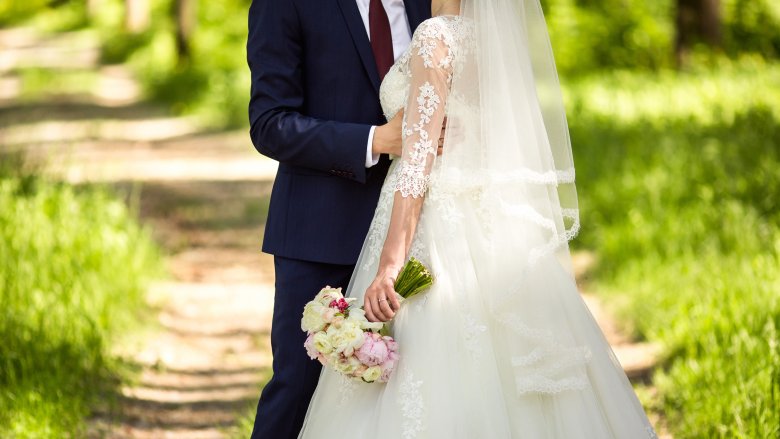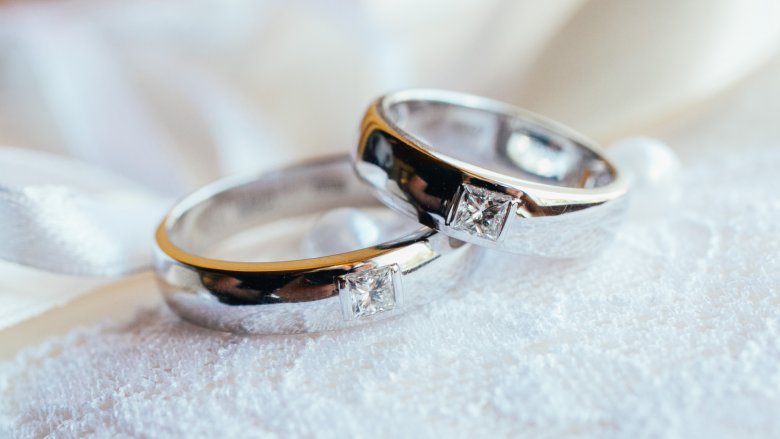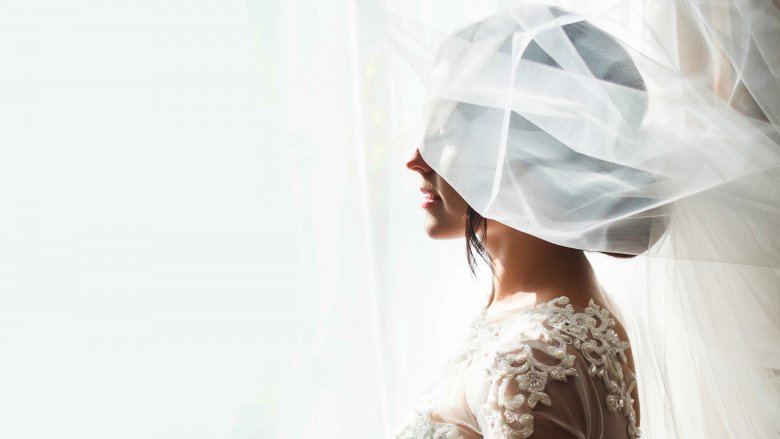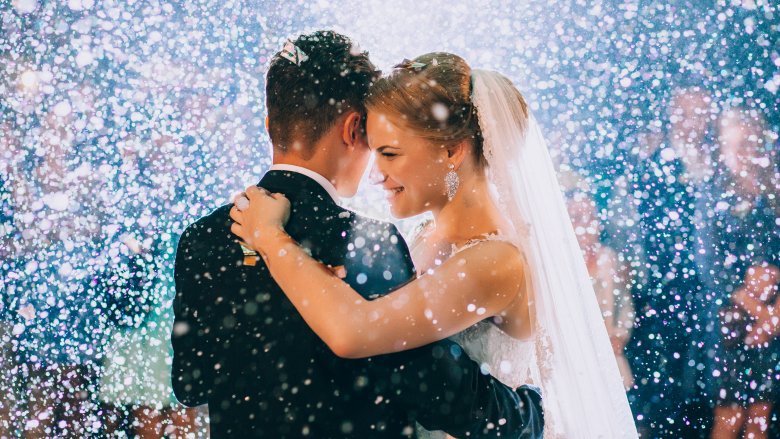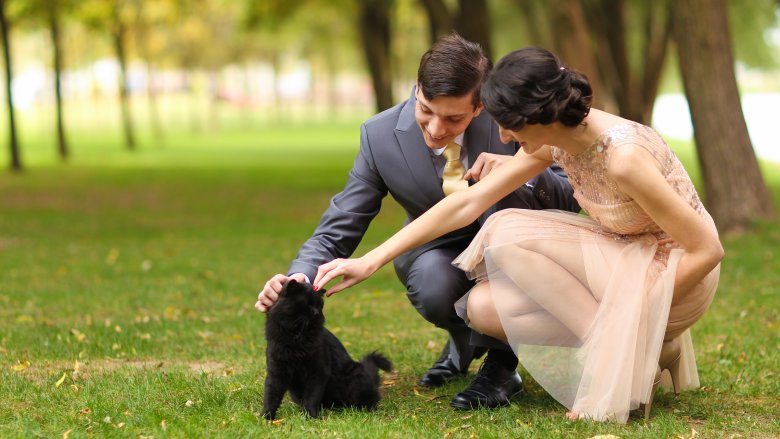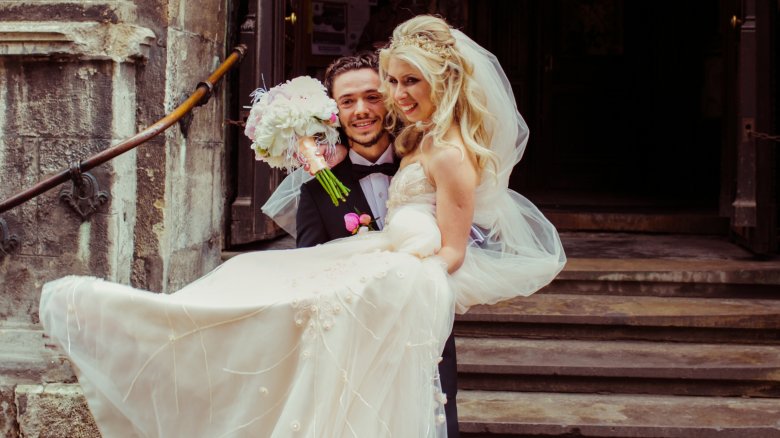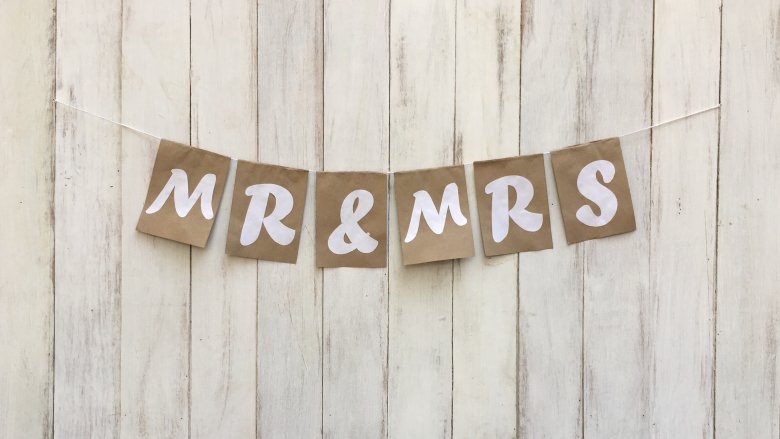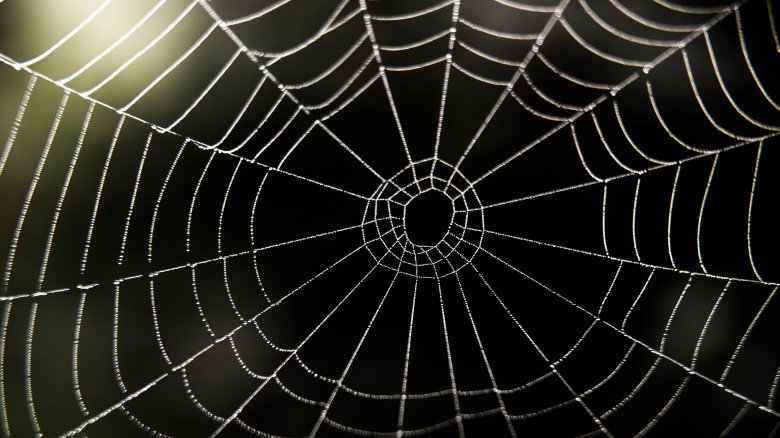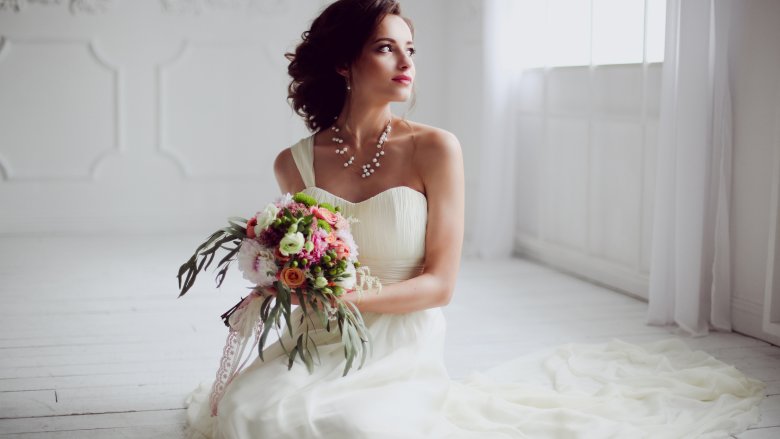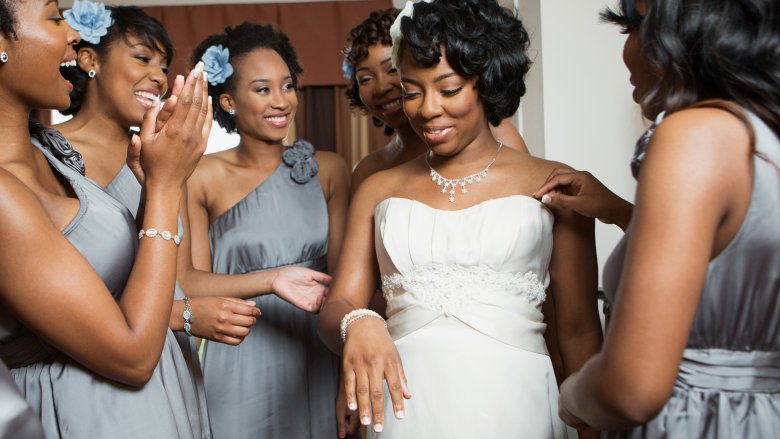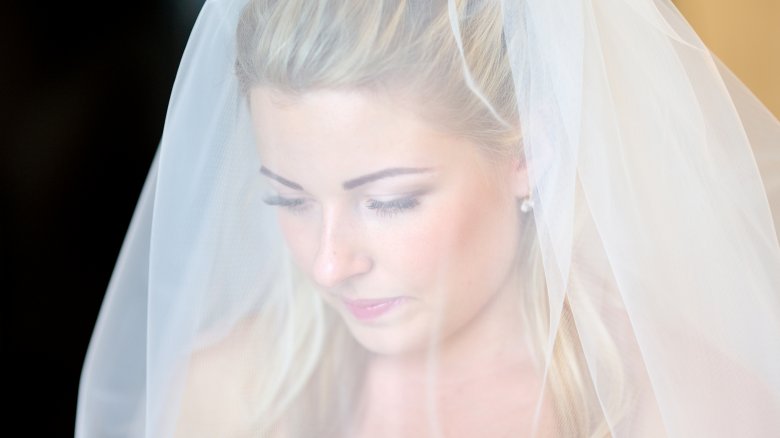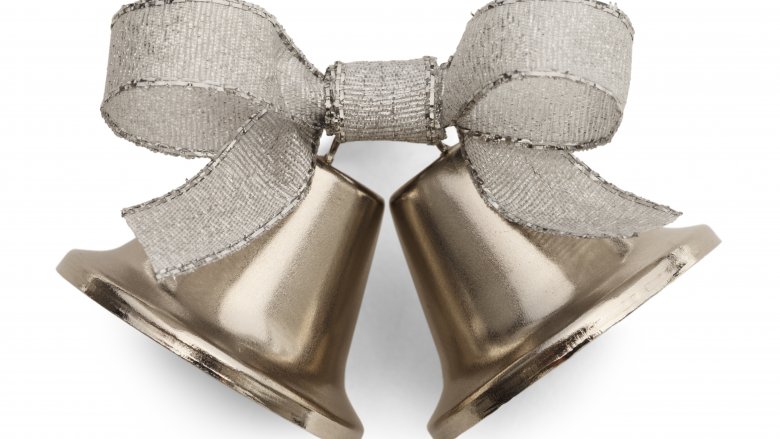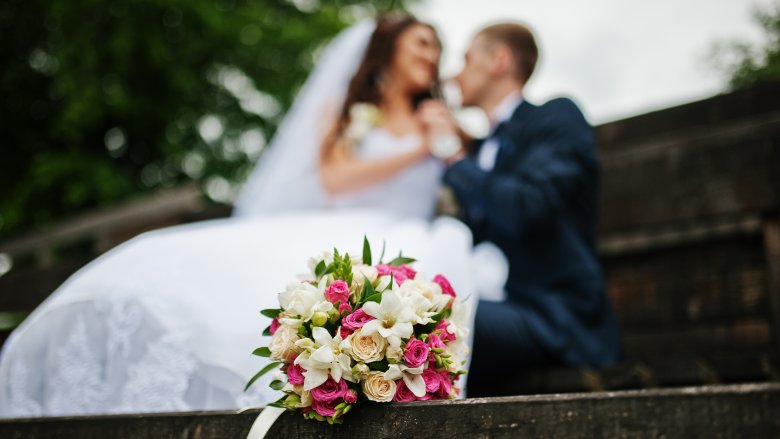Bizarre Wedding Superstitions That People Used To Believe
Weddings have changed a lot over the years, but the desire for everything to go perfectly dates back to even the earliest nuptials. Since ancient times, people have had opinions on things to do and things to avoid to ensure the day went smoothly. Even today's modern brides follow some of these old traditions, such as wearing a white dress and a veil.
But where did these traditions come from? Some wedding traditions are rooted in some pretty bizarre superstitions. Most of the truly outrageous ones have fallen out of style, but some old superstitions are still with us today.
With this ring
Medieval bridal parties were very into death omens. Something completely innocuous, such as a nervous groom dropping the ring at the wedding, was not the result of nerves but rather a telltale sign that he would die before the bride. If the bride dropped the ring, then she would be the first to perish. That's one surefire way to bring down the mood on a happy occasion!
But it doesn't stop there. If someone other than the bride or groom dropped the ring, it didn't necessarily indicate the order in which the happy couple would die unless the ring somehow managed to roll onto a gravestone. If the ring landed on the gravestone of a woman, the bride would die first. If it landed on the gravestone of a man, the groom would be the first.
Marry in May, rue the day
These days, May weddings are pretty popular, but that wasn't always the case. Many believed that getting married in May was bad luck and those who wed in this month would "rue the day." This superstition dates back to ancient Rome, according to bioarchaeologist Kristina Killgrove, where Lemuria, a festival which honored the dead, was held in the month of May.
Bad luck would follow those married in May. The couple would either remain childless, or, if they managed to conceive, would supposedly give birth to children with health issues. On the up side, getting married in June meant you would travel, and getting married in September meant you would live a rich life. So maybe it was worth waiting a month!
Never on a Saturday
Saturday was a bad day for a wedding, according to English folklore. It might be the most popular day for a wedding in modern times, but back then, the English preferred to get married on a Wednesday. A popular rhyme went:
Monday for health,
Tuesday for wealth,
Wednesday best of all,
Thursday for losses,
Friday for crosses,
Saturday for no luck at all.
In Victorian times, they took it one step further. People then believed that it was good luck to get married on the same day of the week that the groom had been born — even if it was on a Saturday.
Here comes the bride
It's a wonder that brides in the olden days made it to their weddings at all considering just how many things were thought to be bad omens. We're all familiar with the tradition of not seeing the groom the day of the wedding until the actual ceremony takes place, but ye olde bride had to avoid more than just her beloved.
Bad luck omens included pigs, hares, open graves, pregnant women, dogs, owls, serpents, nuns, and monks. Even hearing a rooster crowing after dawn was thought to bring ill luck upon a bride, as was meeting another bride on the way to her wedding.
While black cats crossing your path is generally considered to be bad luck, a bride seeing a black cat on the way to her wedding was considered lucky. She would also reap some good luck if she saw a dove, frog, rainbow, lamb, or chimney sweep, causing some brides to employ a chimney sweep on the day of their wedding!
Over the threshold
Carrying the bride over the threshold seems like a cute tradition, right? What could be more romantic than two people, embarking on their new lives together, showing they can support and lean on each other?
The origin of the tradition is a bit more scandalous, however. Back in medieval days, proper European women were not supposed to be enthusiastic about sex and especially not about swiping their v-card. The groom would carry the bride into the bridal chamber to preserve her maidenly shyness.
There was also the threat of evil spirits, which Western Europeans thought would target the happy bride. The groom would carry his new wife into the house so that the spirits could not latch onto her and follow the couple into their home.
What's in a name?
At one point, it was considered to be a bad idea to marry someone whose last name started with the same first letter as yours. A cautionary rhyme noted that this could bring bad luck, warning, "To change the name and not the letter is to change for the worst and not the better."
A bride was also supposed to refrain from writing out her married name before the wedding, as this could tempt fate and prevent the wedding from happening. This old superstition could explain why you never ended up with your middle school crush, no matter how many times you wrote his name with yours on your social studies notebook!
The itsy bitsy lucky spider
If you find a spider in your dress on the day of your wedding, don't freak out! That little guy is actually a good omen. An old English superstition claimed that finding a spider in the folds of a bride's wedding gown would bring her good luck.
Despite this tradition, it's probably not a good idea to let spiders loose on your wedding dress. Your bridesmaids will not appreciate having to hunt down the critters.
White wedding
Most brides these days, at least in Western countries, get married in white dresses. This is a relatively modern tradition, however. White wedding dresses didn't become the standard until the Victorian era, after Queen Victoria herself was married in a white dress in 1840.
Before then, brides usually wore their best clothes for their special day, although they were warned not to march down the aisle in certain colors. Black was considered to be bad luck, even then. Brides were warned that being married in black would make you "wish yourself back." Other unpopular colors were red, yellow, green, and pink.
Something old, something new
Another tradition that many modern brides follow is to carry with them something old, something new, something borrowed, and something blue. The "something old" is meant to honor the past, the "something new" stands for the future, the "something borrowed" is to be lent by a happily married person to pass on some of their good luck, and the "something blue" is meant to represent fidelity and love.
Many British brides still stick with the often forgotten final line of the poem, "A sixpence in your shoe." The money in the bride's shoe is meant to bring prosperity.
Thwarting evil spirits
Belief in the supernatural had a great influence on weddings. It was generally believed that evil spirits would try to thwart the happiness of a bride and groom. For centuries, people did what they could to prevent the evil spirits from harming the couple and devised ways of tricking them.
Many of these traditions remain with us today. For example, bridesmaids originated as decoys: it was thought that by having many young women at the altar, the evil spirits would be confused and not know which was the bride. And veils were meant to further confuse the spirits by obscuring the bride's face.
Ring the bells
Wedding bells were yet another way to scare off evil spirits. It was long believed that church bells had sacred power which could keep people safe. Author I. Bernard Cohen described this power in the book Benjamin Franklin's Science. For centuries, "typical inscriptions on church bells" alluded to their ability to ward off bad weather and malevolent spirits. Used in weddings, bells had a double purpose: not only did they announce the good news of the happy event, but also served to warn off any entities that might try to harm the newlyweds.
Today, bells are still viewed as a symbol of matrimony. In Ireland, many modern brides tuck small bells in their wedding bouquets to honor this old tradition.
All you need is love
In the 21st century, most people no longer believe in the reasons behind these outdated superstitions. While the traditions can be fun to follow, you don't really need to gather good luck tokens or watch out for bad omens. All that is really needed to make a wedding truly lucky is love!
Whether you want to wear white, or take pictures with your beloved before the wedding, the most important thing is the celebration of your commitment to each other.

